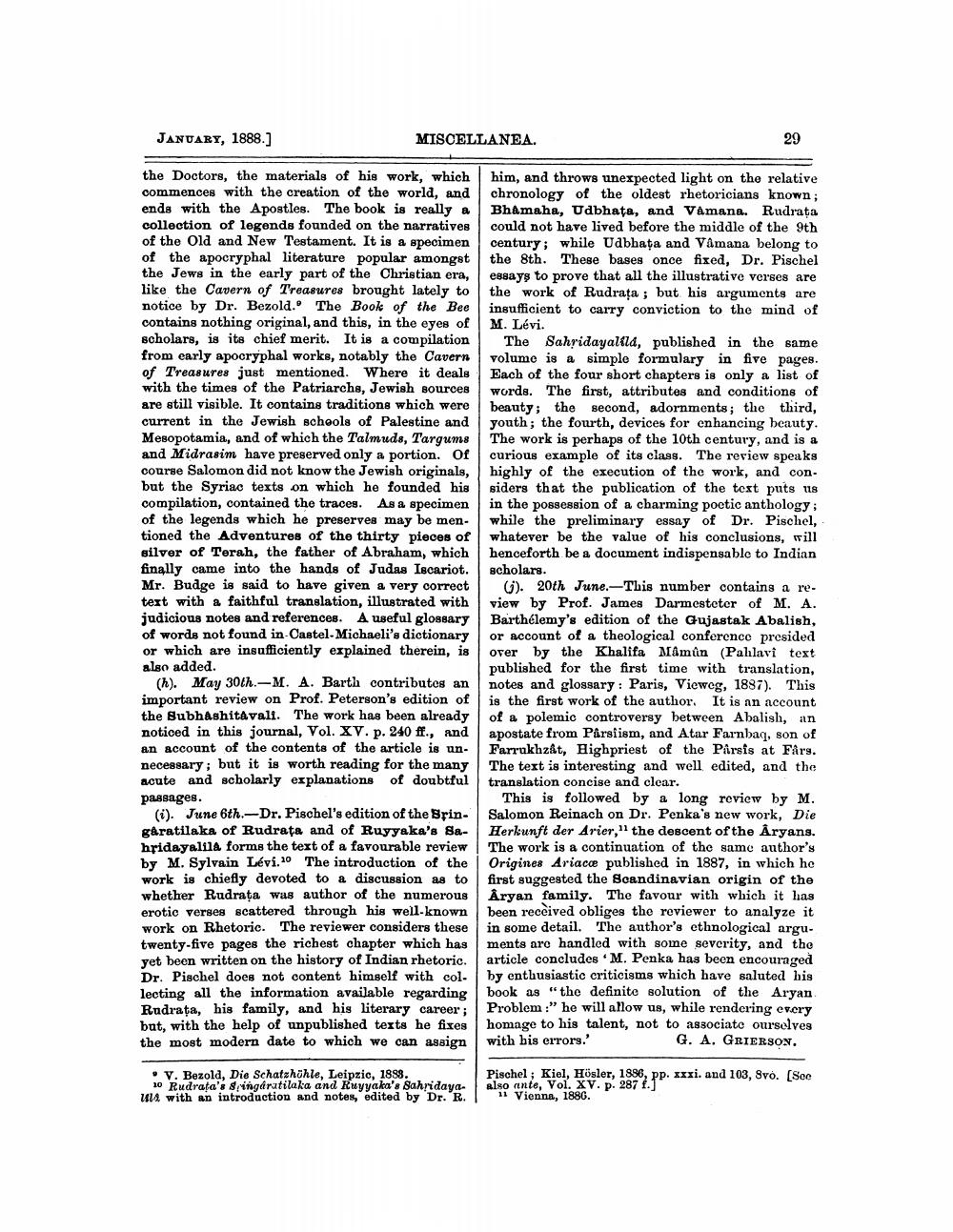________________
JANUARY, 1888.)
MISCELLANEA.
29
the Doctors, the materials of his work, which commences with the creation of the world, and ends with the Apostles. The book is really a collection of legends founded on the narratives of the Old and New Testament. It is a specimen of the apocryphal literature popular amongst the Jews in the early part of the Christian era, like the Cavern of Treasures brought lately to notice by Dr. Bezold. The Book of the Bee contains nothing original, and this, in the eyes of scholars, is its chief merit. It is a compilation from early apocryphal works, notably the Cavern of Treasures just mentioned. Where it deals with the times of the Patriarchs, Jewish sources are still visible. It contains traditions which were current in the Jewish schools of Palestine and Mesopotamia, and of which the Talmuds, Targums and Midrasim have preserved only a portion. Of course Salomon did not know the Jewish originals, but the Syriac texts on which he founded his compilation, contained the traces. As a specimen of the legends which he preserves may be mentioned the Adventures of the thirty pieces of silver of Torah, the father of Abraham, which finally came into the hands of Judas Iscariot. Mr. Budge is said to have given a very correct tert with a faithful translation, illustrated with judicious notes and references. A useful glossary of words not found in Castel. Michaeli's dictionary or which are insufficiently explained therein, is also added.
(h). May 30th.-M. A. Barth contributes an important review on Prof. Peterson's edition of the Subhashitavall. The work has been already noticed in this journal, Vol. XV. p. 240 ff., and an account of the contents of the article is un necessary; but it is worth reading for the many acute and scholarly explanations of doubtful passages.
(). June 6th.-Dr. Pischel's edition of the Spin. gåratilaka of Rudrata and of Ruyyaka's Sahridayalila forms the text of a favourable review by M. Sylvain Lévi.20 The introduction of the work is chiefly devoted to a discussion as to whether Rudrata was author of the numerous erotio verses scattered through his well-known work on Rhetoric. The reviewer considers these twenty-five pages the richest chapter which has yet been written on the history of Indian rhetoric. Dr. Piachel does not content himself with col. lecting all the information available regarding Rudrata, his family, and his literary career; but, with the help of unpublished texts he fixes the most modern date to which we can assign
him, and throws unexpected light on the relative chronology of the oldest rhetoricians known; BhAmaha, Udbhata, and Vamana. Rudrata could not have lived before the middle of the 9th century; while Udbhata and Vamana belong to the 8th. These bases once fixed, Dr. Pischel essays to prove that all the illustrative verses are the work of Rudrata ; but his arguments are insufficient to carry conviction to the mind of M. Lévi.
The Sahridayalkid, published in the same volume is a simple formulary in five pages. Each of the four short chapters is only a list of words. The first, attributes and conditions of beauty; the second, adornments; the third, youth; the fourth, devices for enhancing beauty, The work is perhaps of the 10th century, and is a curious example of its class. The review speaks highly of the execution of the work, and con. siders that the publication of the text puts us in the possession of a charming poetic anthology while the preliminary essay of Dr. Pischel, whatever be the value of his conclusions, will henceforth be a document indispensable to Indian scholars.
6). 20th June.-This number contains a review by Prof. James Darmesteter of M. A. Barthélemy's edition of the Gujastak Abalish, or account of a theological conference presided over by the Khalifa Mamún (Pahlavi text published for the first time with translation, notes and glossary : Paris, Vieweg, 1887). This is the first work of the author. It is an account of a polemic controversy between Abolish, an apostate from Pärsiism, and Atar Farnbaq, son of Farrukhzât, Highpriest of the Parsis at Fårs. The text is interesting and well edited, and the translation concise and clear.
This is followed by a long review by M. Salomon Reinach on Dr. Penka's new work, Die Herkunft der Arier," the descent of the Aryans. The work is a continuation of the same author's Origines Ariace published in 1887, in which he first suggested the Scandinavian origin of the Åryan family. The favour with which it has been received obliges the reviewer to analyze it in some detail. The author's ethnological arguments are handled with some severity, and the article concludes M. Penka has been encouraged by enthusiastic criticisms which have saluted his book as "the definite solution of the Aryan Problem :" he will allow us, while rendering every homage to his talent, not to associate ourselves with his errors.'
G. A. GRIERSON.
• V. Bezola, Die Schatzhühle, Leipzic, 1888. 10 Rudrata' Sringaratilaka and Kuyyaka's Sahridaya.
with an introduction and notes, edited by Dr. R.
Pischel; Kiel, Hösler, 1886, pp. xxxi. and 103, 8vo. (Sce also ante, Vol. XV. p. 287 f.)
11 Vienna. 1880.
U




